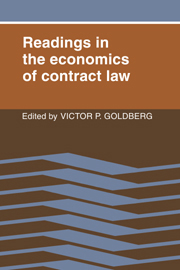Book contents
- Frontmatter
- Contents
- Preface
- Readings in the economics of contract law
- Part I Some preliminaries
- Part II Contract law and the least cost avoider
- Part III The expectation interest, the reliance interest, and consequential damages
- Part IV The lost-volume seller puzzle
- Part V Specific performance and the cost of completion
- Part VI Power, governance, and the penalty clause puzzle
- Part VII Standard forms and warranties
- Part VIII Duress, preexisting duty, and good faith modification
- Part IX Impossibility, related doctrines, and price adjustment
- Questions and notes on impossibility and price adjustment
- References
- Index of cases
- Author index
- Subject index
Part II - Contract law and the least cost avoider
Published online by Cambridge University Press: 10 November 2010
- Frontmatter
- Contents
- Preface
- Readings in the economics of contract law
- Part I Some preliminaries
- Part II Contract law and the least cost avoider
- Part III The expectation interest, the reliance interest, and consequential damages
- Part IV The lost-volume seller puzzle
- Part V Specific performance and the cost of completion
- Part VI Power, governance, and the penalty clause puzzle
- Part VII Standard forms and warranties
- Part VIII Duress, preexisting duty, and good faith modification
- Part IX Impossibility, related doctrines, and price adjustment
- Questions and notes on impossibility and price adjustment
- References
- Index of cases
- Author index
- Subject index
Summary
When two parties enter into a contract, the outcome might ultimately depend upon the subsequent behavior of both of them. The first two selections in Part II begin with this essential insight. Thus, Robert Cooter [2.1] focuses on the harm arising from the breach of a contract and the ability of the parties to avoid that harm – the promisor by reducing the probability that it will breach and the promisee by reducing its reliance on the promisor's performance. Cooter emphasizes the similarity between the problem of controlling the harm arising from a contract breach with that arising from an accident, a nuisance, or a taking of private property by the government. In each context the rules should assign the task of avoiding costs to the party in the best position to do so – the least cost avoider. He points out that the manner in which contract law treats excuses closely parallels the treatment of no liability versus strict liability in torts. He also notes that so long as the victim can influence the magnitude of the harm, a rule of strict liability that places all the avoidance burden on the breacher (or tortfeasor) is inefficient.
Charles Goetz and Robert Scott [2.2] argue that when entering into an agreement the parties rationally attempt to minimize the joint costs of adjusting to prospective contingencies. If that requires them to adjust their behavior over time in response to changed circumstances, then they will want to assign the job of adjusting to particular contingencies to the party in the best position to do so.
- Type
- Chapter
- Information
- Readings in the Economics of Contract Law , pp. 51 - 52Publisher: Cambridge University PressPrint publication year: 1982



